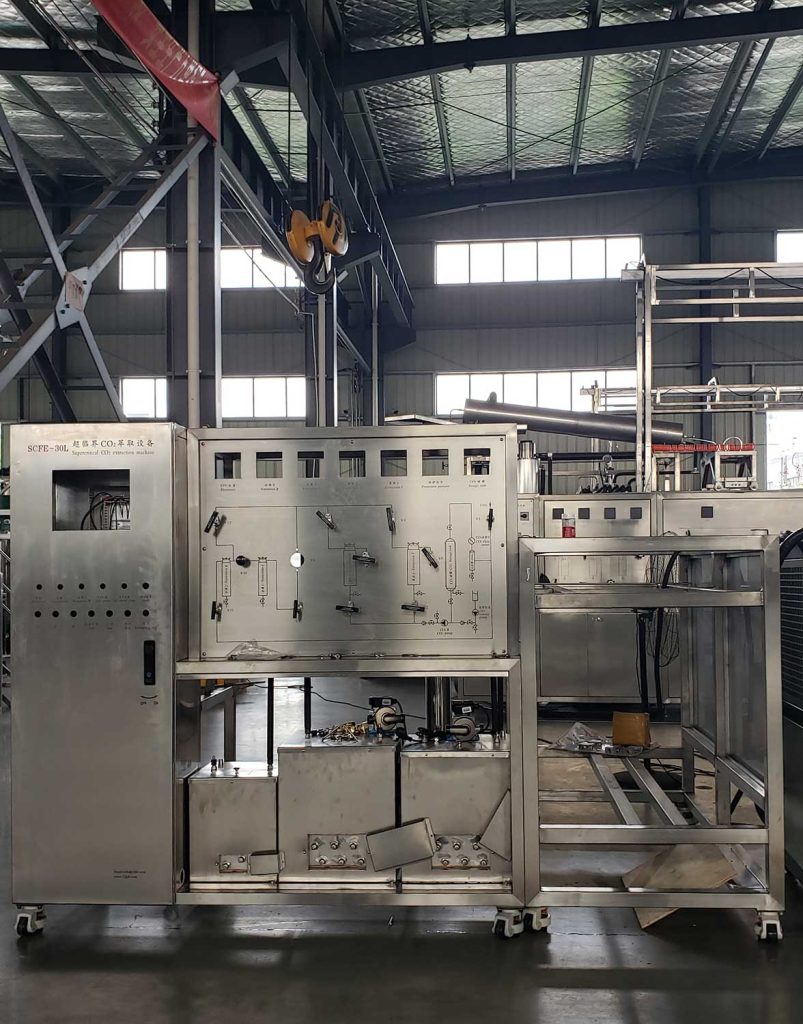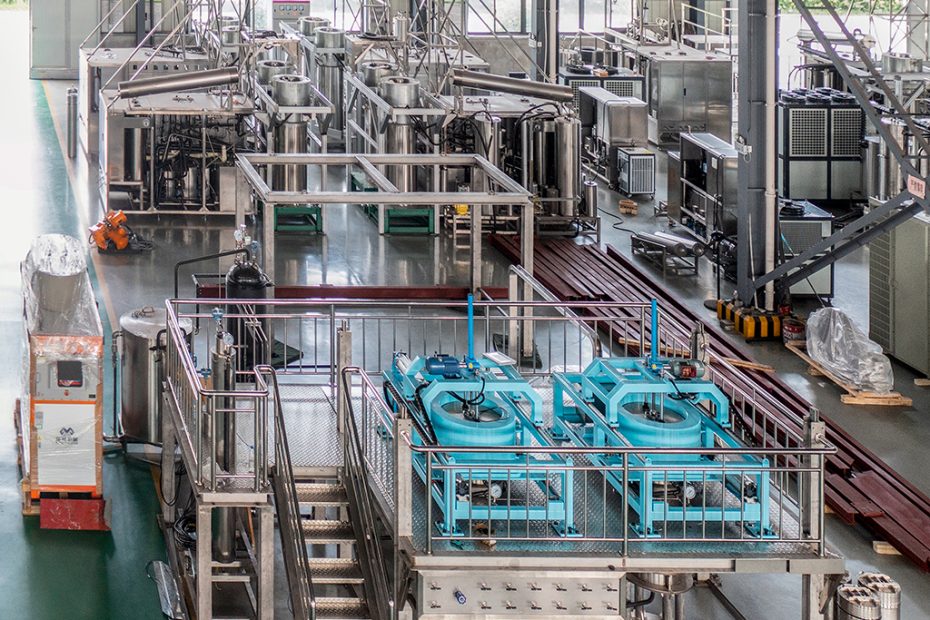The supercritical CO2 fluid extraction process device mainly includes three parts: pre-treatment equipment, extraction equipment, and separation equipment. The main equipment (static equipment) used in the device includes: heat exchanger, extraction kettle, separation kettle, storage tank, etc.
Description of the four main equipment of supercritical extraction device
Heat exchanger
In the supercritical CO2 fluid extraction process, the condensation, pressure increase, vaporization and throttling expansion of the CO2 fluid under different pressures and temperatures are the basic requirements of the extraction process. The phase change process of the CO2 fluid under different conditions is accompanied by a large number of thermal effects. , Therefore, in the research of industrial extraction devices, the calculation of process heat balance and the rational utilization of energy are extremely important.
In the heat balance calculation, the pilot experiment data and heat balance calculation results of the heat exchange of CO2 fluid in the condensation liquefaction system, preheating vaporization system and throttling expansion process under different temperature and pressure conditions can be compared to provide rational utilization of heat energy in the process. And provide a basis for the selection of basic data in heat exchange.
Research shows that the thermal effect associated with the secondary phase change of CO2 fluid and the change of heat with CO2 flow, temperature and pressure have a greater impact on energy consumption, among which the amount of CO2 circulation is the main factor.
The main function of the heat exchanger in the supercritical CO2 fluid extraction process is to make the fluid and extraction materials reach the operating temperature before entering the extraction kettle, and to increase the temperature before entering the separator to facilitate separation, etc.
Type and selection of heat exchanger
Heat exchangers are widely used in chemical production. According to different characteristics such as heat transfer methods, they can be divided into dividing wall heat exchangers, direct heat exchangers and regenerative heat exchangers.
Partitioning wall heat exchanger
The characteristic of the dividing wall heat exchanger is that the hot and cold fluids are separated by a solid wall so that the two fluids do not mix and transfer heat through the solid wall. This type of heat exchanger is widely used in industry.
Partitioning wall heat exchangers can be divided into tubular heat exchangers (such as sleeve type, spray coil type, shell and tube type, etc.) according to the shape and structural characteristics of the heat transfer surface. Plate heat exchangers (such as corrugated plate type, spiral plate type) etc.) and extended surface type (such as plate fin type, tube fin type, etc.). Among the tubular heat exchangers, the shell-and-tube heat exchanger is the most common.
Direct contact heat exchanger
A direct contact heat exchanger is a direct contact between two fluids (cold and hot) after entering the heat exchanger. Its characteristic is that the hot and cold fluids exchange heat by direct mixing. This type of heat exchanger transfers heat with high heat transfer efficiency, but its use is limited and is only suitable for situations where the mixing of the two fluids is allowed.
Regenerative heat exchanger
The regenerative heat exchanger is a space (regenerator) filled with regenerators. Two fluids with different temperatures pass through the regenerator alternately to achieve indirect heat transfer. This heat transfer method is inefficient and requires two fluids. The fluids are allowed to mix.
The hot and cold fluids alternately pass through the regenerator of the heat exchanger, and the regenerator transfers the heat from the hot fluid to the cold fluid to achieve the purpose of heat exchange. There are many factors involved in heat exchanger selection, such as the corrosiveness and other characteristics of the fluid, operating temperature and pressure, temperature difference between hot and cold fluids, maintenance and cleaning requirements, construction investment and recurring operating costs, etc. The specific selection must be comprehensive. consider.
The heat exchanger should have sufficient strength and thermal compensation capabilities, and should be easy to clean. For small installations, a double-casing heat exchanger can be used because it has a simple structure and does not have a flower plate or a head.

A good heat exchanger should have the following characteristics:
- Reasonably realize the specified process conditions;
- The heat transfer rate is large, the fluid flow pressure drop is small, and the structure is compact, which can obtain the best economic benefits;
- Safe and reliable;
- Easy to manufacture, install, operate and maintain.
In chemical production, most of the partition wall heat exchangers are used, which means that two fluids with different temperatures transfer heat across the wall (pipe wall) through which the fluid flows. The two fluids do not contact each other. This method of heat transfer is best suited for chemical production. According to the shape of the partition wall, partition wall heat exchangers can be divided into shell and tube heat exchangers for tube wall heat transfer and plate heat exchangers for plate wall heat transfer.
Extraction kettle
The extraction kettle is one of the key equipment in the supercritical CO2 fluid extraction device. According to different extraction processes and feeding methods, it can be divided into continuous countercurrent extraction and intermittent operation extraction kettles. At present, for liquid materials, continuous countercurrent extraction equipment is generally used, which has the advantages of simple operation, good material contact, and easier temperature control. For solid materials, intermittent extraction equipment is mostly used because solid materials are not easy to operate continuously.
Separation kettle
The supercritical fluid Extraction process carrying a large amount of solute from the top of the extraction kettle first enters the heat exchanger. The temperature of the supercritical fluid increases. After reaching the separation kettle, the pressure further decreases. The solubility of the supercritical fluid decreases rapidly, and a large amount of solute flows from the supercritical fluid. The critical fluid is released and flows out from the bottom of the separation kettle. Therefore, the function of the separation kettle is to effectively separate the extract and the extraction agent.
Storage tank
Storage tanks are indispensable in the supercritical CO2 fluid extraction process. According to their uses, they mainly include storage containers, metering containers, reflux containers, intermediate turnover containers, buffer containers and mixing containers.
The main purpose of the buffer container is to allow a certain amount of accumulation of substances to ensure the stability of the flow operation in the process. Therefore, the extraction agent, entrainer and liquid materials need to enter the buffer first after being pre-treated. In supercritical fluid extraction, a mixing vessel is sometimes required, such as mixing the extraction agent with the entrainer before entering the extraction kettle.
Conclusion
The above introduces the main equipment (static equipment) of the supercritical CO2 fluid extraction process device, including: heat exchanger, extraction kettle, separation kettle, storage tank, etc. The supercritical carbon dioxide extraction process brings opportunities to various industries.
